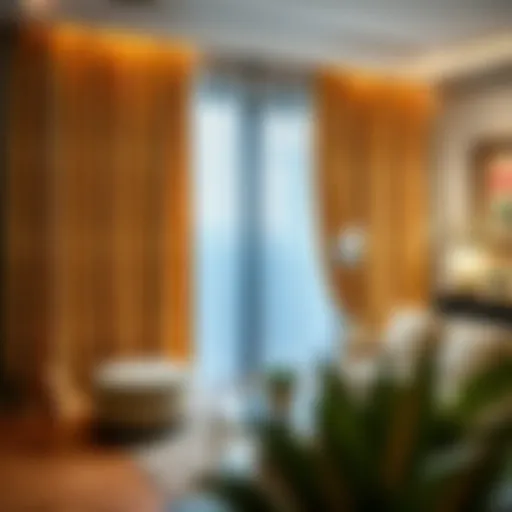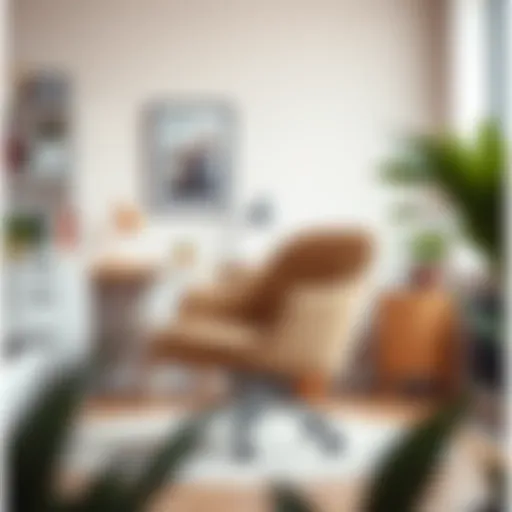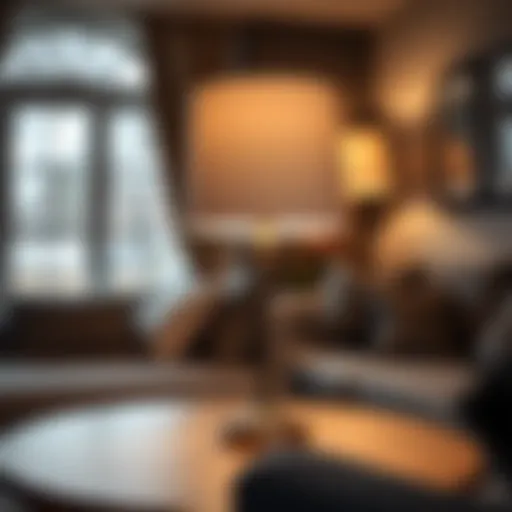Exploring Diverse End Table Options for Your Home


Intro
In the quest for that perfect end table, many homeowners and designers find themselves standing at a crossroads. The choices seem as endless as a horizon, presenting an array of styles, materials, and functionalities. With preferences ranging from rustic wooden designs to sleek contemporary glass tables, it's crucial to consider not just the aesthetic appeal but also how these pieces fit into your living space. This guide is designed to help you navigate the local landscape of end tables, sparking ideas and providing practical insights into your options.
As we delve into the design trends shaping today’s market, we’ll uncover how to weave these styles into the fabric of your home environment. For those looking to make a purchase, the accompanying buying guides will serve as a handy roadmap, ensuring you select a piece that enhances both your space and lifestyle. By the end of this exploration, you'll be well-equipped to tackle your search for an end table that speaks to your needs and showcases your unique style.
Understanding End Tables
End tables might seem like just small pieces of furniture, but they hold much more significance than many realize. Their design and placement within a living space can either contribute to or detract from the overall ambiance and functionality of the room. Understanding end tables is essential for homeowners, designers, retailers, and DIY enthusiasts alike, as it allows for thoughtful design choices that enhance one's home environment.
Definition and Purpose
At the core, an end table, also known as a side table or accent table, serves a fundamental purpose: it offers a convenient surface nearby for everyday items like drinks, books, or remote controls. But its utility can extend far beyond mere surface space. Being often placed next to sofas or chairs, these tables can also reflect the owner’s style, bridging the gap between the functional and decorative aspects of interior design. Beyond functional needs, they can also act as platforms for decor. Think about how a beautifully crafted end table adorned with a lamp or a few well-chosen books can elevate a room’s aesthetic appeal. The right end table can breathe life into an otherwise dull corner, adding layers to the space's narrative.
Historical Context
Tracing back the lineage of end tables, we find that their origin is linked to practicality and craftsmanship. Historically, these tables were used extensively in homes from the Victorian era, where they were typically more decorative and ornate. Often crafted from heavy woods with detailed carvings, they mirrored the intricate design aesthetics of the time. As the decades rolled on, the function of these tables underwent a transformation. The mid-20th century saw a rise in minimalist designs, echoing the simplicity prevalent in the post-war era. End tables shifted from being solely decorative pieces to versatile elements prioritizing functionality while remaining stylish. Today, we witness an eclectic variety of end tables, seamlessly blending both purpose and design, which reflects the diverse tastes of modern homeowners. Understanding this evolution not only provides insight into the cultural shifts over the years but also informs contemporary choices, allowing individuals to select end tables that resonate with their personal history and preferences.
Types of End Tables Available Nearby
Understanding the various types of end tables available locally plays a vital role in shaping the ambiance of your living space. Each category serves unique purposes, appealing to different tastes and functional needs. It's essential to ask yourself: what do you want this piece of furniture to achieve? Whether it's providing a surface for drinks, as a catch-all for remote controls, or simply adding aesthetic value, exploring these types illuminates your options. Here’s a closer look at what’s out there, bringing functionality and artistry into your home in equal measure.
Traditional Designs
Traditional end tables have stood the test of time, often crafted with elegant wood and ornate details that evoke a sense of timeless class. These models usually reflect styles such as Colonial, Victorian, or Rustic, showcasing carving and rich finishes.
- Craftsmanship: Such tables often feature expert woodworking, revealing the dedication put in during their creation. Think mahogany, oak, or cherry wood, which not only endows longevity but also improves with age.
- Classic Aesthetics: Their presence often harks back to an era of grandeur, serving as conversation pieces in the home.
- Considerations: While they tend to be more substantial, it’s worth noting their heft may not align with every modern space design. Ensure that they complement your existing furniture without overpowering.
Often these end tables come equipped with drawers for hidden storage, hence combining beauty with usefulness. If you're a fan of history, a traditional end table might just find a cozy nook in your living room.
Modern Variations
Modern end tables take on a different approach, intertwining minimalism with contemporary style. These tables may sport clean lines, asymmetrical shapes, and innovative materials that reflect today’s trends.
- Material Fusion: Expect to see a mix of metals, glass, and molded plastics, often collaborating with various textures. For instance, a metal frame with a glass top can provide an airy feel in compact spaces.
- Functionality-Focused: In today's fast-paced world, the design often targets practicality, emphasizing multi-purpose usage. For example, a sleek end table can double as a small work desk or a charging station.
- Limited Ornamentation: They avoid excessive frills, reflecting a streamlined aesthetic that appeals to those favoring simplicity. If your style leans toward the modern, these options are sure to resonate.
Modern designs can drastically shift the character of a room, providing the refreshing vibrancy that many homes strive for today.
Multi-functional Options
With living spaces getting smaller, the need for furniture that does double duty has become increasingly important. Multi-functional end tables fit this bill effectively.
- Versatility: These tables might come with shelves, hidden compartments, or even foldable surfaces. Imagine an end table that, when opened, reveals a compact sewing station or an extra leaf for dining.
- Space Savers: Ideal for apartments or smaller homes, these designs maximize utility without crowding the area. You gain not only a stylish piece but also functional help across various tasks.
- Adaptability: Some of these options can be adjusted to suit your needs. Systems like nesting tables provide versatility, allowing you to rearrange as required, almost like furniture chameleons in your living space.
Incorporating a multi-functional end table seamlessly combines style and practicality, making your home environment more dynamic than ever.
By understanding the different types of end tables, you position yourself to make a more informed decision that aligns with your preferences. A thoughtful selection can elevate your living area, serving both aesthetic and practical needs.
Materials Influencing End Table Quality
When it comes to choosing end tables, the materials used are pivotal in determining their overall quality, aesthetic appeal, and functional durability. As these tables often serve as both practical storage solutions and stylish accessories in living rooms, understanding the materials can profoundly influence your decision-making process. Each material has its unique set of characteristics that contribute to the table's longevity, maintenance needs, and overall style. Here’s a closer look at some of the most prominent materials found in end tables today:
Wooden Structures
Wood is a classic choice for end tables, often revered for its beauty and durability. It brings a warm and inviting atmosphere to any space. There are different types of wood you might encounter, such as oak, pine, maple, and walnut, each possessing distinct grain patterns and colors.
- Strength and Durability: Solid wood tables typically offer superior strength compared to manufactured options, making them a long-lasting investment.
- Aesthetic Versatility: The variety in wood types means that there’s a finish or grain pattern to fit various decor styles—from rustic to modern.
- Repairability: Scratches and minor dents can often be sanded down or refinished, enhancing longevity.
However, wooden end tables do require some care. They may need occasional oiling or waxing to maintain their finish, and they can be sensitive to moisture and heat.
Metal Frameworks
Metal, particularly in contemporary designs, brings an industrial edge to end tables. Options include stainless steel, aluminum, or wrought iron, each offering unique benefits:
- Longevity: Metal is highly durable and can withstand the test of time, often resisting wear and tear better than wood.
- Finishes and Styles: You can find metal tables in various finishes, including brushed, polished, or painted surfaces, giving homeowners flexibility in design.
- Ease of Maintenance: Cleaning metal surfaces is often simpler; a quick wipe down with a damp cloth typically does the trick.
Nonetheless, metal tables can sometimes be heavier and may not provide the same warmth as wood. Plus, without proper treatment, they could be prone to rusting, particularly in humid environments.
Glass Elements
Glass top tables are increasingly popular for their sleek, modern appearance. A few key points to consider:
- Illusion of Space: Glass tables tend to create an airy feel, making rooms appear larger than they are. This makes them a favored choice amongst designers for small spaces.
- Style Statement: They can add a contemporary flair and complement various styles, allowing for creative designs through unique base structures.
- Right Amount of Maintenance: While they can be easy to clean, glass surfaces are also vulnerable to scratches and may require protection from heavy items.
On the downside, glass might not offer the stability you find in wood or metal, particularly if the base isn’t sturdy enough. It’s essential to consider the durability of the supporting structures.
"The material of your end table isn't just about looks; it's about building a functional relationship with your living space that balances style and strength."
Functional Aspects of End Tables
With the ongoing evolution in home décor and furnishings, end tables have morphed from mere supporting characters into essential players in our living spaces. Recognizing their functional aspects is paramount, especially for homeowners and enthusiasts seeking to maximize utility without skimming on style. An end table isn’t just a piece of furniture; it serves multiple purposes that can greatly enhance the overall functionality of a room.
Space Optimization
When it comes to optimizing space, end tables can be game changers, particularly in smaller living areas. They can fill awkward corners or tight spaces, allowing for thoughtful placement without overcrowding. A well-chosen end table can act as a visual anchor in a room, helping to define a space while maintaining an open, airy feel. For instance, a slim, round table fits snugly beside a sofa, permitting easy access to both the seating and the table without feeling intrusive. This approach not only conserves floor space but can also enhance traffic flow, making the environment feel more cohesive.
Moreover, the height and size of the table must complement your seating arrangements. If a table sits too high or low, it disrupts sight lines and accessibility, undermining its purpose. Consider height variations when selecting a table. For example, a low-profile table next to a high sofa may frustrate users trying to reach for drinks or books, while conversely, an overly tall table might loom over your seating uncomfortably.
Storage Solutions


Beyond their placement capabilities, many end tables come packed with storage features. These tables can include drawers, shelves, or cabinets, providing hidden compartments to stash away items like remote controls, magazines, or any other miscellaneous items we seem to accumulate. With this added functionality, end tables help keep clutter at bay and contribute to a cleaner, more organized living space.
For instance, an end table with a shelf could house decorative boxes that conceal items, keeping the surface tidy and artfully arranged. Around homes, this kind of functionality stands out, especially in family rooms where kids' toys may need quick stowing.
"Choosing an end table involves thinking about your daily habits—small, clever storage can transform chaos into calm and enhance the overall vibe of your space."
When weighing storage options, look out for tables that offer versatility. A table featuring pull-out sections or removable trays can adapt to your needs and function as temporary dining or workspace. End tables with integrated charging stations for devices are another current trend. These additions make it easier to keep items powered up and within reach.
Aesthetic Considerations in Design
When selecting an end table, aesthetic considerations can’t be swept under the rug. They play a crucial role in defining the ambiance of your living space. It’s not just about functionality; it’s about how well the table harmonizes with your overall decor. The right end table can accentuate your room's character while adding a touch of elegance or coziness, depending on your personal style. Let’s break this down into several key components: color coordination, shape and size, and surface finish variances.
Color Coordination
Color coordination is essential when determining how the end table will integrate into your environment. The palette of your room sets the mood, and the end table can either enhance or detract from it. For example, if your room is designed in soft, muted tones, opting for a vibrant-colored table could create a visual discord. In contrast, a table that matches or complements the colors present can tie the room together beautifully.
- Consider the color scheme: hues that match wall colors or larger furniture can create a unified look.
- Accent Colors: Utilizing a table as a pop of color can bring life to a neutral space.
"Choosing colors is like painting a picture; you need to know what you want to convey with each piece."
A good method to explore color options is to refer to resources such as Color Theory on Wikipedia. Here you can better understand how different shades can influence emotional responses and visual appeal.
Shape and Size
The shape and size of an end table are not just about fitting in space; they influence the traffic flow in a room and the visual dynamics as well. A larger, rectangular table may work perfectly beside a sectional couch but could cut off movement if placed next to a smaller seating arrangement. The key is to find balance.
- Proportionality matters: A small, delicate table can easily be overwhelmed by a large sectional sofa, and vice versa.
- Geometry’s role: Round tables often soften the look of a space, while square or rectangular tables provide a more modern edge.
Choosing the right shape and size involves considering existing furniture and the overall layout of your area. Measure your space before making a selection so there are no unpleasant surprises.
Surface Finish Variances
The finish on an end table can add depth to your design and contribute to its overall feel. Whether it’s a glossy lacquer that captures light or a matte finish that absorbs it, the surface texture impacts how we perceive the furniture.
- Glossy finishes: Often create a modern, chic look and may reflect light, brightening the space.
- Matte finishes: Tend to offer a more rustic or cozy feel, perfect for creating an inviting atmosphere.
When choosing a finish, think also about practical considerations. For example, high-gloss surfaces may be prone to fingerprints while textured finishes could be more forgiving. Overall, the finish you choose should resonate with not only the aesthetic you aim for but also your lifestyle preferences.
By thoughtfully considering these aesthetic aspects, you can select an end table that is not just functional, but also a true centerpiece in your living space.
Local Sources for End Tables
When it comes to selecting end tables, the local sources have a unique charm and practicality that online shopping might not fully capture. Not only do they offer a chance to physically inspect the quality of materials and craftsmanship, but they also present a tactile experience that is vital in making a well-rounded choice. Visiting stores in your area means you can evaluate the end tables against your decor, visualize how they fit in your space, and even engage with knowledgeable staff who can provide insights tailored to your needs.
Furniture Showrooms
Furniture showrooms are a treasure trove of options when you’re on the hunt for end tables. Picture this: walking into a space designed entirely for showcasing beautiful furniture. The ability to see, touch, and even sit beside these pieces allows for a richer understanding of their scale and presence. Showrooms often feature an array of styles, from sleek contemporary designs to more rustic, vintage-inspired pieces.
Moreover, the benefit of visiting a showroom is the guidance you can get from sales staff. They might share tips on maintenance or trends you weren’t aware of, tailoring their advice to your specific tastes. Additionally, don't hesitate to ask for recommendations based on your current home aesthetic or intended function of the end table.
- Interactive Experience: You can witness firsthand the nuances of various designs, ensuring balance in your home layout.
- Variety of Styles: Most showrooms carry diverse stock, which affords you the chance to explore options you may never consider otherwise.
Online Retail Platforms
In contrast, the world of online retail presents an expansive space—virtually endless choices at your fingertips. You could explore platforms like Wayfair, Amazon, or Target, where you can filter through thousands of end tables in just a few clicks. The convenience of shopping from home is often unmatched, especially for those who may find visiting multiple stores daunting or time-consuming.
However, it is important to navigate this digital shopping with care. Reading customer reviews can provide valuable insights into a product’s durability and true appearance, which might differ from the images. Always check the dimensions closely so you don't end up with something that overwhelms or underwhelms when it arrives. It’s wise to compare prices, as online platforms often run sales or have exclusive discounts.
"Shopping online is like a treasure hunt; sometimes you find jewels, sometimes just pebbles."
Secondhand Options
For those open to a more adventurous approach, secondhand options can be quite rewarding. Local thrift stores, flea markets, or even websites like Facebook Marketplace and Craigslist can reveal unique finds that blend charm and character. These pieces often tell a story, with their wear and tear adding to their allure. Plus, purchasing secondhand is an environmentally conscious choice that supports sustainability.
When searching for secondhand end tables:
- Inspect Carefully: Look closely for structural integrity and any potential damage.
- Think Refurbish: Don’t shy away from something that needs a little TLC, as many tables can be easily updated with new paint or hardware.
Ultimately, whether you opt for a pristine piece from a showroom, search the web for a fantastic deal, or discover a hidden gem at a secondhand store, sourcing end tables locally ensures a personalized touch that enhances your living environment.
How to Choose the Right End Table
Choosing the right end table can be a pivotal decision when it comes to achieving the desired ambiance and utility in your living space. End tables serve not only as functional pieces but also as design statements that reflect personal taste. To ensure your choice aligns seamlessly with your home, a few key elements are crucial to consider.
Assessing Your Space
Before any purchase, it’s smart to size up your area. Take a moment to measure the dimensions of the spot where you plan to place the end table. Think about the room's overall layout; does the end table fit within your design scheme or will it become an obstruction in a busy pathway? A table that’s too large can overwhelm the space, while one that’s too small can miss the mark entirely.
Make a note of existing furniture too, as the style and height should synchronize. If you have a low-slung sofa, opt for a table that maintains a similar stature; if your couch is a tad lofty, go for a taller model. Pro Tip: Keep a distance of about 18 inches between the end table and your seating for comfortable access.
Identifying Your Style
Next up is figuring out what tickles your fancy design-wise. The variety of end tables out there can make your head spin; from rustic wooden options to sleek metallic structures, it helps to reflect on what matches your home's personality. Consider the overall decor theme—is it contemporary, vintage, or perhaps mid-century modern? Your end table should harmonize with these elements.
Color is also a big deal. If your decor is bright and vibrant, a bold colored table might add to that energy, whereas if you prefer a calmer look, subdued tones might serve you better. Don’t forget details like textures and patterns. These can truly tie a room together. Following a specific aesthetic such as farmhouse or industrial can make your choices clearer.
Setting a Budget
Let’s talk money—setting a budget is not just wise; it’s essential. End tables can range from a steal to quite the pricey investment, so determine what you're willing to spend before jumping into the sea of options. This will prevent you from falling head over heels for a piece that's way outside your financial comfort zone.
Consider the quality versus cost ratio. Sometimes, spending a little more can get you a table that withstands the test of time, while cheaper alternatives may require replacements sooner than you'd like. Allocate a percentage of your home furnishing budget to this piece, and you’ll navigate your options more effectively without losing track of your finances.


Choosing the right end table isn't just about function; it's about making a statement. A well-placed end table can elevate the entire room.
By covering these three elements – assessing your space, identifying your style, and setting a budget – you’re laying a solid foundation for making a savvy decision that complements your living area. Take it step by step, and you'll find the end table that suits your needs perfectly.
Navigating Trends in End Table Design
When it comes to selecting end tables, understanding the trends in design is pivotal. As styles evolve, the choices for end tables reflect currents in art, functionality, and personal taste. This section delves into trends shaping the end table market, highlighting why staying updated can greatly enhance your selection process.
Recognizing these trends allows homeowners and designers alike to make informed choices, ensuring the furniture not only looks great but also harmonizes with the rest of the living space. By keeping an eye on popular styles and sustainable materials, one can strike a balance between aesthetics, functionality, and environmental responsibility.
Current Popular Styles
Navigating the labyrinth of end tables starts by understanding what's hot right now in the world of design. Consider these trending styles, which cater to various tastes:
- Mid-Century Modern: Characterized by clean lines and organic shapes, this style has seen a resurgence. Tables with tapered legs and rich wood grains are making a comeback, allowing for a nostalgic yet fresh touch.
- Industrial: This style combines metal and wood, lending an edgy charm to spaces. End tables featuring reclaimed wood tops affixed to metal bases not only provide function but also serve as conversation starters.
- Scandinavian Minimalism: With its focus on simplicity and functionality, Scandinavian design often incorporates light wood and neutral colors. End tables in this realm often feature a sleek, understated design that doesn’t overwhelm the space.
- Bohemian & Eclectic: A mix-and-match approach that celebrates individuality is gaining traction. Think unique shapes, vibrant colors, and unusual materials that represent personal stories and travels.
- Smart Tables: Integrated technology is increasingly popular. End tables with built-in charging stations or Bluetooth speakers combine functionality with modern living needs.
“A well-chosen end table can be the jewelry of a room; it accentuates your décor while providing vital function.”
Sustainable Materials
The shift towards eco-friendly options is influencing end table design, underscoring a commitment to sustainability.
- Reclaimed Wood: One of the most sought-after materials today, reclaimed wood not only contributes to sustainability but also brings unique character to each piece. Each table tells a story, with its rich textures and history.
- Bamboo: Fast-growing and remarkably sturdy, bamboo is a material being embraced for end tables. Its light color and durability make it a strong contender for modern spaces.
- Recycled metals: Crafting tables from recycled metals minimizes resource use while delivering a contemporary aesthetic. This trend aligns with the rising demand for industrial styles.
- Sustainable finishing: Environmentally friendly finishes are becoming the norm, with brands opting out of harmful chemicals in favor of natural oils and stains.
By integrating these sustainable materials, the choice of end tables reflects a broader commitment to responsible design choices, appealing to anyone conscious about the environmental impact of their decisions.
Care and Maintenance of End Tables
Caring for and maintaining end tables is crucial for ensuring that they not only remain aesthetically pleasing but also functional over time. These pieces often serve as hubs for everyday activities—think of them as the little workhorses of your living space. Regular care can extend their lifespan, preserving both their beauty and function. Whether you're a homeowner investing in a stylish piece or a designer looking to maintain a specific aesthetic, a thoughtful approach to care can make all the difference.
The benefits of proper maintenance are manifold. First and foremost, it can protect against wear and tear, which is especially important for those multi-functional tables that see a lot of use. Additionally, maintaining the finish can keep the table looking new, while also preventing any long-term damage that could require costly repairs or replacements.
Cleaning Techniques
Using the right cleaning technique is essential for maintaining your end table, regardless of the material it's made from. Here are some practical techniques to consider:
- Dusting Regularly: Use a soft microfiber cloth to whisk away dust and debris. This simple act can prevent scratches that dirt might cause over time.
- Wipe Down Surfaces: For a deeper clean, use a slightly damp cloth with a gentle, non-abrasive cleaner. Always follow up with a dry cloth to remove moisture; standing water can warp the surface.
- Stain Removal: If food spills or drink stains occur, addressing them quickly can be key. A mix of water and vinegar or a specialized cleaner for the material can help lift those marks without causing damage.
- Polishing: For wooden tables, using a polish every few months can enhance the shine and offer a protective layer. Choose a product appropriate for the wood type, avoiding any heavy oils that might attract more dust.
"Regular cleaning doesn’t just make your end tables look good, it also enhances their enduring charm.”
Preventing Damage
Taking proactive measures to prevent damage to your end tables is as important as cleaning them. Here’s how you can safeguard your tables:
- Coasters and Placemats: Always keep coasters handy for drinks, as condensation can leave rings or even warp surfaces. Placemats are great for food to shield the end table from heat or spills.
- Avoid Direct Sunlight: Positioning tables out of direct sunlight can prevent fading or discoloration of finishes. Sun exposure can be surprisingly damaging over time.
- Temperature Fluctuations: End tables made of wood are sensitive to humidity and temperature variation. Keeping them in a stable environment minimizes the risk of warping or cracking.
- Proper Use: Avoid using your end tables as impromptu ladders or storage units for heavy objects. They’re not built for that, and strain can lead to structural issues.
By following these cleaning techniques and preventive measures thoughtfully, homeowners and enthusiasts can maintain the vibrancy of their end tables, ensuring they remain a functional and stylish part of their living spaces for years to come.
For further information on furniture care, consider visiting resources like The Spruce or Good Housekeeping. They provide excellent tips and more detailed guides tailored to various furniture types.
Popular Brands and Their Offerings
When it comes to selecting end tables, knowing about various popular brands can significantly impact your decision. Established brands usually provide a mix of quality assurance and aesthetically appealing designs, while emerging designers could surprise with unique, innovative approaches that cater to niche markets. This section dives into both ends of that spectrum, aiming to equip you with comprehensive knowledge of what’s out there and how these brands contribute to the world of end tables.
Established Manufacturers
Established manufacturers are often the backbone of the furniture industry, with a wealth of experience and a solid reputation on their side. Companies such as Pottery Barn, West Elm, or IKEA have built their brand around the promise of durability and style. They offer end tables that often blend modern, classic, and transitional designs, allowing homeowners to choose options that mesh well with diverse decor themes.
Each brand has its unique selling point. For instance, Pottery Barn focuses on classic designs and sustainable practices, appealing to those who value tradition and environmental responsibility. West Elm puts a spotlight on mid-century modern designs, infusing vibrant colors and lines that cater to hip, urban dwellers. Meanwhile, IKEA is renowned for its efficiency in price and space-saving designs, perfect for apartments or smaller homes.
Some notable benefits of established brands include:
- Quality Assurance: Long-standing brands have established quality control practices, ensuring their products are built to last.
- Design Variety: They often offer a broad range of styles to suit different tastes.
- Customer Support: Established manufacturers tend to provide better after-sales support, warranties, and return policies.
"Investing in quality, whether from an established manufacturer or an emerging designer, always pays off in the long run."
Emerging Designers
On the other end, emerging designers bring fresh perspectives to the furniture space. They often challenge traditional norms and experiment with unconventional materials, shapes, and finishes. Designers like Josie Steverson and Reuben Doolittle are gaining traction for their bold designs that evoke conversations while providing functionality.
Supporting these designers can be a delightful journey of discovery. One major advantage is the ability to find end tables that are genuinely unique, which means your living space can stand out from the crowd. For instance, Josie Steverson creates pieces that often incorporate recycled materials, blending ecological responsibility with artistic expression. Similarly, Reuben Doolittle focuses on geometric shapes, making practical use of negative space in stunning ways.
Things you might appreciate about emerging designers include:
- Originality: Their pieces are less likely to be mass-produced, allowing for unique creations that reflect personal style.
- Cultural Influences: Many new designers draw from diverse cultural experiences, infusing global inspirations into their work.
- Sustainable Practices: Emerging designers are often at the forefront of eco-friendly materials and production methods, aligning with evolving consumer values.
In summation, whether you opt for the tried-and-true reliability of established brands or the innovative flair of new designers, the world of end tables offers myriad options suited to various tastes and needs.
Comparative Analysis of End Table Features
The world of end tables is as diverse as it is functional. A comparative analysis of end table features is crucial for anyone looking to enhance their living spaces. It serves to highlight essential qualities and characteristics that can make or break a purchase decision. This analysis helps homeowners and designers sift through various options, weighing the pros and cons of functionality against aesthetics, ultimately helping them find that perfect piece that aligns with their needs and style.
Functionality vs. Design
When it comes to furniture selection, function and form often dance a delicate tango. On one hand, the functionality of end tables can’t be overstated. They serve as a convenient surface for holding drinks, snacks, or even books. This utilitarian aspect is frequently the first factor most individuals consider. For instance, features such as built-in storage or extendable surfaces add practical value, catching the eye of those who prioritize utility.
However, design plays its own crucial role. The visual appeal of an end table can influence the overall ambiance of a room. A beautifully crafted table can act as a statement piece, elevating the entire aesthetic of a space. Homeowners should think about how the style of the end table harmonizes with existing decor.
Balancing these two aspects can be tricky. For example, a sleek glass table may look modern and chic but may not hold up well in a busy family home where kids run around. Conversely, a sturdy wooden table with drawers for storage might lack the visual pop desired in a minimalist setting.
Thus, one must ask: Will the end table blend seamlessly into the existing decor while also serving its intended purpose? Getting this balance right is fundamental for an informed purchasing decision.


Price Comparisons
Engaging in a price comparison is fundamental, especially as end tables can range from budget-friendly options to high-end designer pieces. A savvy buyer should also remember that price often reflects quality and longevity.
- Budget Options: Many local furniture stores or online marketplaces offer end tables that won’t break the bank—think popular retailers like IKEA or Wayfair. These are often good for renters or those who might change their decor frequently.
- Mid-range Choices: Brands like West Elm or Crate & Barrel offer stylish options that provide a decent balance between quality and price. Here, you might find unique designs without splurging too heavily.
- Luxury Brands: For those seeking a statement piece crafted from exceptional materials, consider looking at brands such as Baker Furniture or Roche Bobois. While these options come at a premium, they often deliver timeless style and durability.
A deeper dive into comparison can yield further insights. Understand what features justify a higher price tag. For instance, does that rich walnut finish improve durability, or is it purely aesthetic? Knowing these details enables a more judicious selection process.
A well-placed end table can become a conversation starter, so choose wisely — the difference between cheap and expensive could be based not only on looks but also on long-term satisfaction.
When it comes to selection, whether for personal enjoyment or resale value, understanding the intricate landscape of end table features is essential. Remember that every choice reflects a balance between usefulness and style, with price acting as a guiding metric for what best fits your lifestyle.
Insights from Interior Designers
When delving into the realm of end tables, one must not overlook the invaluable perspectives offered by interior designers. Their expertise can significantly inform how one approaches the selection and placement of these pieces within a living space. Designers can discern not just aesthetics but also practical elements that cater to lifestyle needs.
Expert Recommendations
Interior designers often emphasize the importance of balance and cohesion when selecting end tables. They recommend considering the following guidelines:
- Complement Your Existing Furniture: End tables should harmonize with your current decor. Whether it’s a vintage sofa or a sleek sectional, choosing a table that echoes the shapes and colors helps create a unified look.
- Functionality Matters: Designers advise homeowners to think about how they will use the end table. Is it a spot for a lamp, a drink, or perhaps a place to recharge devices? Understanding its purpose is crucial for selecting shapes and sizes.
- Height Consideration: A common pitfall is failing to match the height of your end tables with the adjoining seating. Designers often suggest a height within two inches of the sofa arm for a seamless flow. This small detail can drastically improve the space's overall comfort and usability.
Case Studies
To illustrate these recommendations further, consider these two contrasting case studies:
Urban Chic Studio
In a small urban studio, an interior designer worked with limited space. They chose a transparent acrylic end table, which offered functionality without overwhelming the visual area. This choice reflected the homeowner's modern style while allowing for ease of movement and visibility, making the studio feel larger than it actually was.
Rustic Cabin Retreat
In a rustic cabin, the designer opted for a vintage reclaimed wood end table. The rough texture and natural finish added warmth to the space and echoed other design elements, like exposed beams and stone fireplace. This choice not only provided function but also captured the character of the home, demonstrating that an end table can be a focal point rather than just an accessory.
In both cases, the interior designers’ recommendations transformed the spaces into functional masterpieces, highlighting the critical role end tables play in home decor.
In summary, insights from interior designers remind us that choosing end tables isn't merely about aesthetics. It's about understanding the broader context of your living environment and ensuring that each piece fits snugly into your life style.
The Future of End Tables
The landscape for end tables is evolving rapidly, influenced by various trends ranging from sustainability to technological advancements. This section will delve into what the future holds for these essential pieces of furniture. Understanding these shifts is crucial for homeowners, designers, and retailers, as it helps ensure that selections made today align with tomorrow's preferences and values.
Innovations in Design
In recent years, the design of end tables has seen a significant transformation. Designers are pushing boundaries by using unconventional materials and bold forms to create unique pieces that serve both a functional purpose and as statement items in living spaces.
Material Evolution
The future of end tables is not just about aesthetics; it's about materials that carry meaning. For example, reclaimed wood and recycled metals are becoming more prominent as a response to environmental concerns. These materials not only reduce waste but also offer stories that contemporary pieces often lack.
Smart Features
Integrating technology into end tables is another trend. Imagine an end table with built-in wireless charging capabilities, LED lights for ambiance, or even Bluetooth speakers. These innovations create multifunctional furniture that meets the demands of modern living. Coupled with user-friendly designs, they're appealing for tech-savvy consumers.
"Innovative designs will bridge the gap between utility and artistry in a way that resonates with the modern homeowner."
Customization and Personal Touch
Another notable trend is personalization. With brands now offering customizable options—from finishes and colors to sizes and hardware—end tables can reflect individual styles better than ever before. Homeowners can create a piece that perfectly aligns with their room's decor while showcasing their personality.
Predicted Trends
As we look toward the future, various trends are expected to shape the end table market. These predictions provide insight into consumer behavior and preferences that can help inform better buying decisions.
Rise of Minimalism
Minimalism continues to gain traction. Consumers are gravitating toward clean lines and simple designs that emphasize functionality without excess. This trend is likely to lead to streamlined end tables devoid of unnecessary embellishments, focusing instead on essential features that complement a clutter-free living environment.
Eco-Friendly Choices
Sustainability may not just be a buzzword; it’s expected to be a significant influence in furniture design moving forward. Shoppers increasingly prefer products that have less impact on the environment. Companies will likely respond with materials and processes that honor eco-friendly practices, making sustainable designs not only desirable but accessible.
Multi-Functionality
Finally, the trend of multi-functional furniture will persist. As living spaces shrink, the demand for pieces that serve more than one purpose will only increase. Expect end tables that convert into stools, side cabinets, or even decorative platforms. This adaptability will be key for urban dwellers and those looking for versatile solutions.
By staying informed about these innovations and trends, you can better navigate the options for end tables that will not only fulfill your current needs but also remain relevant in the years to come.
Closure
Reflecting on the exploration of end tables, it's evident that these pieces of furniture carry more than just practical value; they serve as crucial touchpoints in our living spaces that enhance both functionality and aesthetics. The significance of selecting the right end table cannot be underestimated, as it intertwines with the overall decor and usability of any room. Each choice, whether inspired by modern trends or traditional designs, can make your space feel more cohesive and welcoming.
Recapitulating Key Points
In our journey through the various aspects of end tables, several critical points have emerged:
- Diverse Styles: We’ve seen a variety of end table styles that cater to all tastes, from traditional wood carvings to sleek modern designs. This diversity allows for personalization in your living areas.
- Functional Materials: Various materials like wood, metal, and glass contribute differently to durability and aesthetics. The right material can significantly enhance the longevity and appeal of an end table.
- Space Considerations: Choosing an end table isn’t just about looks; it’s also crucial to consider the spaces available in your home. Opting for multi-functional tables can serve a dual purpose, saving space while adding utility.
- Local Availability: Being informed about local sources, including furniture showrooms and online platforms, empowers you to make informed decisions without unnecessary delays.
These takeaways underscore the multifaceted role that end tables play in our homes. They are not merely supplementary furniture, but rather essential components that can both elevate and optimize our living spaces.
Final Thoughts on Selection
As you embark on the journey to select the perfect end table, keep in mind that it’s not just about choosing what looks good at first glance. Delve deeper into how each piece resonates with your personal style and fits into your living environment. Consider the color schemes of your room, the proportion of the furniture, and how the table can serve your functional needs.
Whether it’s a sleek glass design that reflects light beautifully, or a sturdy wooden table that evokes warmth and tradition, selection involves balancing aesthetic desires with practical requirements.
Remember, the right end table is an investment that can transform your space, harmonizing it in ways that are both visible and subtle.
For more insights and ideas on choosing quality end tables, consider visiting trusted sources such as Wikipedia on furniture basics or Reddit for real-life testimonials and suggestions.
Let your end table be more than just a stand for books and glasses; let it be a part of your home’s story.















